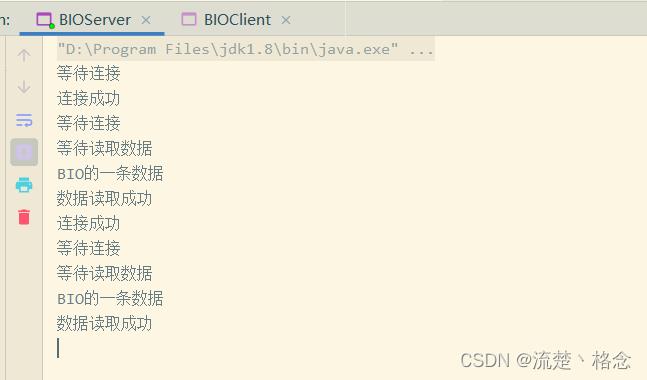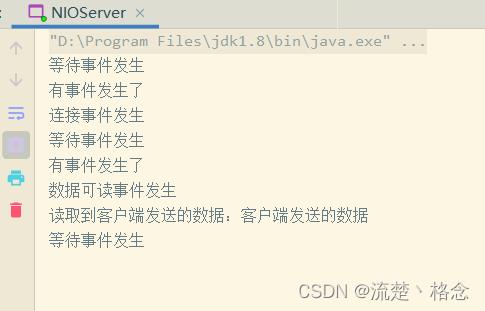BIONIOAIO 代码实战
Posted 流楚丶格念
tags:
篇首语:本文由小常识网(cha138.com)小编为大家整理,主要介绍了BIONIOAIO 代码实战相关的知识,希望对你有一定的参考价值。
文章目录
IO
IO流是Java中比较难理解的一个知识点,但是IO流在实际的开发场景中经常会使用到,比如Dubbo底层就是NIO进行通讯。本文将介绍Java发展过程中出现的三种IO:BIO、NIO以及AIO,重点介绍NIO。
BIO
BIO概念
BIO即同步阻塞IO,实现模型为一个连接就需要一个线程去处理。这种方式简单来说就是当有客户端来请求服务器时,服务器就会开启一个线程去处理这个请求,即使这个请求不干任何事情,这个线程都一直处于阻塞状态。
BIO模型有很多缺点,最大的缺点就是资源的浪费。想象一下如果QQ使用BIO模型,当有一个人上线时就需要一个线程,即使这个人不聊天,这个线程也一直被占用,那再多的服务器资源都不管用。
BIO代码实现
我们通过socket模拟BIO的实现逻辑
首先建立Server,建立一个ServerSocket对象,绑定端口,然后等待连接,如果连接成功就新建一个线程去处理连接。然后在Client使用Socket进行连接服务器。
Server代码:
package com.yyl.iotest.bio;
import java.io.IOException;
import java.net.InetSocketAddress;
import java.net.ServerSocket;
import java.net.Socket;
public class Bioserver
private static Socket socket = null;
public static void main(String[] args)
// 启动socket
try
//绑定端口
ServerSocket serverSocket = new ServerSocket();
serverSocket.bind(new InetSocketAddress(8880));
// 监听socket
while (true)
// 等待连接 阻塞
System.out.println("等待连接");
socket = serverSocket.accept();
System.out.println("连接成功");
//连接成功后新开一个线程去处理这个连接
new Thread(new Runnable()
@Override
public void run()
byte[] bytes=new byte[1024];
try
System.out.println("等待读取数据");
//等待读取数据 阻塞
int length=socket.getInputStream().read(bytes);
System.out.println(new String(bytes,0,length));
System.out.println("数据读取成功");
catch (IOException e)
e.printStackTrace();
).start();
catch (IOException e)
e.printStackTrace();
Client代码:
package com.yyl.iotest.bio;
import java.io.IOException;
import java.net.Socket;
public class BIOClient
public static void main(String[] args)
Socket socket= null;
try
socket = new Socket("127.0.0.1",8880);
socket.getOutputStream().write("BIO的一条数据".getBytes());
socket.close();
catch (IOException e)
e.printStackTrace();
运行结果:

NIO
NIO概念
BIO是阻塞的,如果没有多线程,BIO就需要一直占用CPU,而NIO则是非阻塞IO,NIO在获取连接或者请求时,即使没有取得连接和数据,也不会阻塞程序。
NIO的服务器实现模式为一个线程可以处理多个请求(连接)。
NIO有几个知识点需要掌握,Channel(通道),Buffer(缓冲区), Selector(多路复用选择器)。
Channel既可以用来进行读操作,又可以用来进行写操作。NIO中常用的Channel有FileChannel、SocketChannel、ServerSocketChannel、DatagramChannel。
Buffer缓冲区用来发送和接受数据。
Selector 一般称为选择器或者多路复用器 。它是Java NIO核心组件中的一个,用于检查一个或多个NIO Channel(通道)的状态是否处于可读、可写。在javaNIO中使用Selector往往是将Channel注册到Selector中。

下面我通过代码的方式模拟javaNIO的运行流程。
NIO代码实现
首先贴上NIO的实践代码:
NIO服务端详细的执行过程是这样的:
1、创建一个ServerSocketChannel和Selector,然后将ServerSocketChannel注册到Selector上
2、Selector通过select方法去轮询监听channel事件,如果有客户端要连接时,监听到连接事件。
3、通过channel方法将socketchannel绑定到ServerSocketChannel上,绑定通过SelectorKey实现。
4、socketchannel注册到Selector上,关心读事件。
5、Selector通过select方法去轮询监听channel事件,当监听到有读事件时,ServerSocketChannel通过绑定的SelectorKey定位到具体的channel,读取里面的数据。
Server代码:
package com.yyl.iotest.nio;
import java.io.IOException;
import java.net.InetSocketAddress;
import java.nio.ByteBuffer;
import java.nio.channels.SelectionKey;
import java.nio.channels.Selector;
import java.nio.channels.ServerSocketChannel;
import java.nio.channels.SocketChannel;
import java.util.Iterator;
public class NIOServer
public static void main(String[] args) throws IOException
//创建一个socket通道,并且设置为非阻塞的方式
ServerSocketChannel serverSocketChannel = ServerSocketChannel.open();
serverSocketChannel.configureBlocking(false);
serverSocketChannel.socket().bind(new InetSocketAddress(8881));
//创建一个selector选择器,把channel注册到selector选择器上
Selector selector = Selector.open();
serverSocketChannel.register(selector, SelectionKey.OP_ACCEPT);
while (true)
System.out.println("等待事件发生");
selector.select();
System.out.println("有事件发生了");
Iterator<SelectionKey> iterator = selector.selectedKeys().iterator();
// 交给selector去处理
while (iterator.hasNext())
SelectionKey key = iterator.next();
iterator.remove();
handle(key);
private static void handle(SelectionKey key) throws IOException
if (key.isAcceptable())
System.out.println("连接事件发生");
ServerSocketChannel serverSocketChannel = (ServerSocketChannel) key.channel();
// 创建客户端一侧的channel,并注册到selector上
SocketChannel socketChannel = serverSocketChannel.accept();
socketChannel.configureBlocking(false);
socketChannel.register(key.selector(), SelectionKey.OP_READ);
else if (key.isReadable())
System.out.println("数据可读事件发生");
SocketChannel socketChannel = (SocketChannel) key.channel();
ByteBuffer buffer = ByteBuffer.allocate(1024);
int len = socketChannel.read(buffer);
if (len != -1)
System.out.println("读取到客户端发送的数据:" + new String(buffer.array(), 0, len));
// 给客户端发送信息
ByteBuffer wrap = ByteBuffer.wrap("hello world".getBytes());
socketChannel.write(wrap);
key.interestOps(SelectionKey.OP_READ | SelectionKey.OP_WRITE);
socketChannel.close();
Client代码:
package com.yyl.iotest.nio;
import java.io.IOException;
import java.net.InetSocketAddress;
import java.nio.ByteBuffer;
import java.nio.channels.SelectionKey;
import java.nio.channels.Selector;
import java.nio.channels.SocketChannel;
import java.util.Iterator;
public class NIOClient
public static void main(String[] args) throws IOException
//配置基本的连接参数
SocketChannel channel = SocketChannel.open();
channel.configureBlocking(false);
Selector selector = Selector.open();
channel.connect(new InetSocketAddress("127.0.0.1", 8881));
channel.register(selector, SelectionKey.OP_CONNECT);
// 轮询访问selector
while (true)
selector.select();
Iterator<SelectionKey> iterator = selector.selectedKeys().iterator();
while (iterator.hasNext())
SelectionKey key = iterator.next();
iterator.remove();
//连接事件发生
if (key.isConnectable())
SocketChannel socketChannel = (SocketChannel) key.channel();
//如果正在连接,则完成连接
if (socketChannel.isConnectionPending())
socketChannel.finishConnect();
socketChannel.configureBlocking(false);
ByteBuffer buffer = ByteBuffer.wrap("客户端发送的数据".getBytes());
socketChannel.write(buffer);
socketChannel.register(selector, SelectionKey.OP_READ);
else if (key.isReadable())
//读取服务端发送过来的消息
read(key);
private static void read(SelectionKey key) throws IOException
SocketChannel socketChannel = (SocketChannel) key.channel();
ByteBuffer buffer = ByteBuffer.allocate(512);
int len = socketChannel.read(buffer);
if (len != -1)
System.out.println("客户端收到信息:" + new String(buffer.array(), 0, len));
效果大概是这样的:首先服务端等待事件发生,当客户端启动时,服务器端先接受到连接的请求,接着接受到数据读取的请求,读完数据后继续等待。

客户端发送数据后,获取到了来自服务端的回复。

NIO通过一个Selector,负责监听各种IO事件的发生,然后交给后端的线程去处理。NIO相比与BIO而言,非阻塞体现在轮询处理上。BIO后端线程需要阻塞等待客户端写数据,如果客户端不写数据就一直处于阻塞状态。而NIO通过Selector进行轮询已注册的客户端,当有事件发生时才会交给后端去处理,后端线程不需要等待。
AIO
AIO概念
AIO是在JDK1.7中推出的新的IO方式–异步非阻塞IO,也被称为NIO2.0,AIO在进行读写操作时,直接调用API的read和write方法即可,这两种均是异步的方法,且完成后会主动调用回调函数。简单来讲,当有流可读取时,操作系统会将可读的流传入read方法的缓冲区,并通知应用程序;对于写操作而言,当操作系统将write方法传递的流写入完毕时,操作系统主动通知应用程序。
Java提供了四个异步通道:AsynchronousSocketChannel、AsynchronousServerSocketChannel、AsynchronousFileChannel、AsynchronousDatagramChannel。
AIO代码实现
服务器端代码:AIO的创建方式和NIO类似,先创建通道,再绑定,再监听。只不过AIO中使用了异步的通道。
package com.yyl.iotest.aio;
import java.io.IOException;
import java.net.InetSocketAddress;
import java.nio.ByteBuffer;
import java.nio.channels.AsynchronousServerSocketChannel;
import java.nio.channels.AsynchronousSocketChannel;
import java.nio.channels.CompletionHandler;
import java.util.concurrent.TimeUnit;
public class AIOServer
public static void main(String[] args)
try
//创建异步通道
AsynchronousServerSocketChannel serverSocketChannel=AsynchronousServerSocketChannel.open();
serverSocketChannel.bind(new InetSocketAddress(8882));
System.out.println("等待连接中");
//在AIO中,accept有两个参数,
// 第一个参数是一个泛型,可以用来控制想传递的对象
// 第二个参数CompletionHandler,用来处理监听成功和失败的逻辑
// 如此设置监听的原因是因为这里的监听是一个类似于递归的操作,每次监听成功后要开启下一个监听
serverSocketChannel.accept(null, new CompletionHandler<AsynchronousSocketChannel, Object>()
//请求成功处理逻辑
@Override
public void completed(AsynchronousSocketChannel result, Object attachment)
System.out.println("连接成功,处理数据中");
//开启新的监听
serverSocketChannel.accept(null,this);
handledata(result);
@Override
public void failed(Throwable exc, Object attachment)
System.out.println("失败");
);
try
TimeUnit.SECONDS.sleep(Integer.MAX_VALUE);
catch (InterruptedException e)
e.printStackTrace();
catch (IOException e)
e.printStackTrace();
private static void handledata(AsynchronousSocketChannel result)
ByteBuffer byteBuffer=ByteBuffer.allocate(1024);
//通道的read方法也带有三个参数
//1.目的地:处理客户端传递数据的中转缓存,可以不使用
//2.处理客户端传递数据的对象
//3.处理逻辑,也有成功和不成功的两个写法
result.read(byteBuffer, byteBuffer, new CompletionHandler<Integer, ByteBuffer>()
@Override
public void completed(Integer result, ByteBuffer attachment)
if (result>0)
attachment.flip();
byte[] array = attachment.array();
System.out.println(new String(array));
@Override
public void failed(Throwable exc, ByteBuffer attachment)
System.out.println("失败");
);
客户端代码基本上没有太多差别,主要还是实现数据的发送功能
package com.yyl.iotest.aio;
import java.io.IOException;
import java.net.InetSock以上是关于BIONIOAIO 代码实战的主要内容,如果未能解决你的问题,请参考以下文章